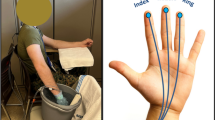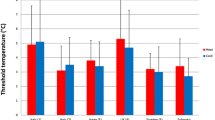Abstract
This study compares male and female contact cooling responses in order to ascertain whether a particular sex is at a greater risk to cold injury. Ten volunteers (five male, five female) participated, touching blocks of four different materials (aluminium, stainless steel, nylon and mahogany wood) with finger contact forces of 1.0 N, 2.9 N and 9.8 N, at a range of surface temperatures (−35°C to +5°C) appropriate for the thermal properties of the material. Contact temperature (T C) of the finger-pad was measured over time using a T-type thermocouple. Under fast cooling conditions (below 10 s to reach T C=0.5°C), no significant difference was found between the cooling responses of males and females (P>0.05) for the 12 conditions tested. Under slow cooling conditions (above 10 s to reach T C=0.5°C), females were found to have significantly faster skin cooling than males (P<0.05) for 18 of the 24 conditions tested. In order to investigate whether differences in hand anthropometry between these representative groups of males and females were related to differences in contact cooling response under slow-cooling conditions, a general linear model approach was used. Subsequent analyses of the residual variance in contact cooling data after the effects of material type, finger contact force and surface temperature had been accounted for showed that both sex and hand size correlated significantly with contact cooling response (P≤0.001) with hand size showing the stronger impact and possibly being the determining factor. Conclusive proof of the latter would require an additional experiment using males and females of equal hand dimensions instead of representative groups as used here. This study showed females to be at a higher risk during contact with cold objects.






Similar content being viewed by others
References
Bollinger A, Schlumpf M (1976) Finger blood flow in healthy patients of different age and sex and in patients with primary Raynaud’s disease. Acta Chir Scand 465:42–47
Burse RL (1979) Sex differences in human thermoregulatory response to heat and cold stress. Hum Factors 21:687–699
Chen F, Nilsson H, Holmér I (1992) Cooling of the finger pad touching different material surfaces. In: Lotens WA, Havenith G (eds) Proceedings of 5th International Conference on Environmental Ergonomics, Maastricht, pp 60–61
Chen F, Nilsson H, Holmér I (1994a) Cooling responses of finger in contact with an aluminium surface. Am Ind Hyg Assoc J 55:218–222
Chen F, Nilsson H, Holmér I (1994b) Finger cooling by contact with cold aluminium surfaces—effects of pressure, mass and whole body thermal balance. Eur J Appl Physiol 69:55–60
Enander A (1986) Sensory reactions and performance in moderate cold. Arbete och Hälsa, Sölna
Enander A (1989) Effects of thermal stress on human performance. Scand J Work Environ Health 15 [Suppl 1]:27–33
Geng Q, Holmér I and Cold surfaces research group (2000) Finger contact cooling on cold surfaces: effect of pressure. In: Werner J, Hexamer M (eds) Proceedings of 9th International Conference on Environmental Ergonomics. Shaker, Aachen, Germany, pp 185–188
Geng Q, Holmér I and Cold Surfaces Research Group (2001) Change in the skin-surface interface temperature of finger touching on cold surfaces. Int J Ind Ergon 27:1–6
Havenith G, Van de Linde EJG, Heus R (1992) Pain and thermal sensation and cooling rate of hands while touching cold materials. Eur J Appl Physiol 65:43–51
Havenith, G, Heus R, Daanen HAM (1995) The hand in the cold: performance and risk. Arctic Med Res 54 [Suppl 2]:1–11
Holmér I, Havenith G, Hartog E den, Rintamäki H, Malchaire J, Geng Q, Jay OE, Powell SL, Rissanen S (2000) Temperature limit values for cold touchable surfaces. Final report on the project SMT4-CT97-2149. European Union
Jay OE, Havenith G (2002) Skin contact with cold materials: a comparison between the fingerpad responses of the dominant and non-dominant hand for short-term exposures. In: Tochihara Y (ed) 10th International Conference on Environmental Ergonomics. Fukuoka, Japan, pp 259–262
Keatinge WR, Evans M (1960) Effect of food, alcohol and hyoscine on body-temperature and reflex responses of men immersed in cold water. Lancet 2:176–178
Lewis T, Love WS (1926) Vascular reactions of skin to injury; effects of freezing, of cooling and of warming. Heart 13:27–60
Malchaire J, Geng Q, Den Hartog E, Havenith G, Holmer I, Piette A, Powell SL, Rintamaki H, Rissanen S (2002) Temperature limit values for gripping cold surfaces. Ann Occup Hyg 46:157–163
Provins KA, Morton R (1960) Tactile discrimination and skin temperature. J Appl Physiol 15:155–160
Wilson O, Goldman RF (1970) Role of air temperature and wind in the time necessary for a finger to freeze. J Appl Physiol 29:658–664
Wilson O, Goldman RF, Molnar GW (1976) Freezing temperature of finger skin. J Appl Physiol 41:551–558
Yoshida A, Matsui I, Taya H (1989) References on contact with hot and cold surfaces, tactile warmth and warmth of floors. Technical Report ISO/TC159/SC5/WG1/187. International Standardisation Organisation, Geneva
Acknowledgements
This research was sponsored by the European Union (Contract SMT4-CT97-2149). The experiments performed comply with current United Kingdom law.
Author information
Authors and Affiliations
Corresponding author
Rights and permissions
About this article
Cite this article
Jay, O., Havenith, G. Finger skin cooling on contact with cold materials: a comparison between male and female responses during short-term exposures. Eur J Appl Physiol 91, 373–381 (2004). https://doi.org/10.1007/s00421-003-0986-0
Accepted:
Published:
Issue Date:
DOI: https://doi.org/10.1007/s00421-003-0986-0




